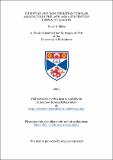Files in this item
Christian and non-Christian Templar associates in the 12th and 13th century crown of Aragon
Item metadata
| dc.contributor.advisor | Kennedy, Hugh (Hugh N.) | |
| dc.contributor.author | Stiles, Paula R. | |
| dc.coverage.spatial | xiv, 239 p. | en_US |
| dc.date.accessioned | 2018-06-01T12:43:33Z | |
| dc.date.available | 2018-06-01T12:43:33Z | |
| dc.date.issued | 2005 | |
| dc.identifier.uri | https://hdl.handle.net/10023/13665 | |
| dc.description.abstract | This thesis seeks to illuminate the nature, extent and complexity of Templar interactions with their associates, particularly non-Christians, women and Mozarabs, by examining these interactions where the most evidence exists for them---northeastern Spain. Evidence for Temple associations with both Christians and non-Christians is strongest and most prolonged here. The overall nature of these interactions was friendlier than expected in a crusading group. In fact, Templars actively competed with the secular Church, nobility and the king in the Crown of Aragon for lordship over non-Christians because non-Christians were a lucrative tax base. Some non-Christians also sought association with the Templars because the Templars were a strong, international group with friendly ties to the Aragonese kings. The Temple could therefore offer protection from other lords against excessive taxation and exploitation, and physical attack. Documentary evidence shows mutually beneficial interactions as the Temple's (and its non-Christian associates') ongoing preference over time and space. Chapter one examines Templar interactions in general, both with associates and non-associates. Chapter two looks at Templar associations in Novillas, the first Templar house founded in the Crown of Aragon. Chapter three deals with the Tortosa and the lower Ebro Valley, which has the most varied surviving Templar documentation in the areas studied. Chapter four deals with Gardeny (in Lleida/Lerida), which has the largest number of surviving documents for all of the areas in the study. Chapter five looks at Monzon and Barcelona, the main Templar houses for Aragon and Catalonia respectively. The last chapter deals with Huesca, the northernmost house in the study. | en_US |
| dc.language.iso | en | en_US |
| dc.publisher | University of St Andrews | |
| dc.subject.lcc | CR4755.S7S8 | |
| dc.subject.lcsh | Templars--Spain--Aragon | en |
| dc.subject.lcsh | Aragon (Spain)--History | en |
| dc.subject.lcsh | Christians--Spain--Aragon--History | en |
| dc.subject.lcsh | Jews--Spain--Aragon--History | en |
| dc.subject.lcsh | Muslims--Spain--Aragon--History | en |
| dc.title | Christian and non-Christian Templar associates in the 12th and 13th century crown of Aragon | en_US |
| dc.type | Thesis | en_US |
| dc.type.qualificationlevel | Doctoral | en_US |
| dc.type.qualificationname | PhD Doctor of Philosophy | en_US |
| dc.publisher.institution | The University of St Andrews | en_US |
This item appears in the following Collection(s)
Items in the St Andrews Research Repository are protected by copyright, with all rights reserved, unless otherwise indicated.

